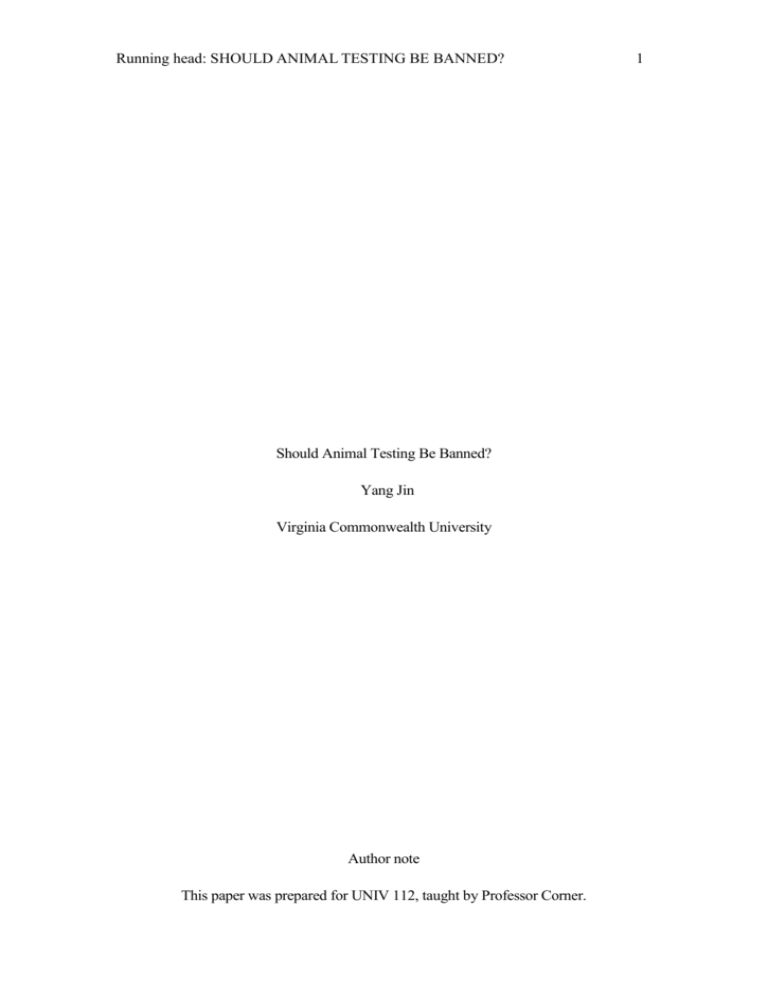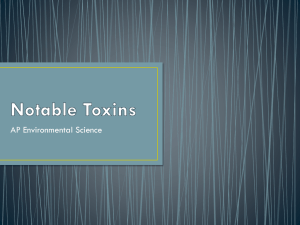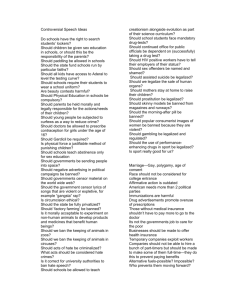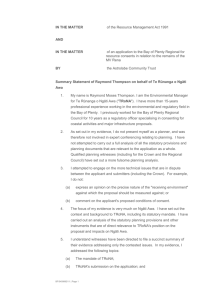3 - Ram Pages
advertisement

Running head: SHOULD ANIMAL TESTING BE BANNED? Should Animal Testing Be Banned? Yang Jin Virginia Commonwealth University Author note This paper was prepared for UNIV 112, taught by Professor Corner. 1 SHOULD ANIMAL TESTING BE BANNED? 2 Animal testing is the use of non-human animals in the experiment. Some people think animal testing is good for humanity and society development. However, everything has two sides. Lots of people regard animal testing as an unfair and cruel treatment for animals and appeal to society to ban animal testing for protecting animals’ rights and health. With the people’s understanding of animal testing, animal testing gradually accepted by more people and should not be banned because of several reasons. The range of conducted of Animal testing is wide and testing and research usually conducted in universities, pharmaceutical companies, farms and defense establishments etc. There are many laws and provision of animal testing are formulated by animals association and government. There is an important principle for more ethical use of animals in testing called The Three Rs which was first described in “The principles of humane experimental technique” written by W.M.S. Russell. The Three Rs are Replacement, Reduction and Refinement. Replacement is that try to use any alternative testing methods instead of animal testing if it could reach the same scientific aims as get from animal testing; Reduction is that researchers refers to the preferred use of methods that able to get similar information from the fewer number of animals or to get more information by testing on same number of animals; Refinement is that to refers to the methods that reduce as much as possible animals’ pain and possibility of getting disease and enhance as much as possible animals’ welfare during animals research. There is an another famous law called “The Animal Welfare Act (AWA)”, the only U.S. federal law that covers animals in research. “The AWA requires that minimum standards of care and SHOULD ANIMAL TESTING BE BANNED? 3 treatment be provided for certain animals bred for commercial sale, used in research, transported commercially, or exhibited to the public.” Animal testing is helpful to scientific and medical development. Certainly, with the development of medical and scientific technology, people’s life quality gets a quite high improvement. Animal testing is one of the most effective and direct way during the medical and scientific research. The convincing results get from animal testing save lots of time, energy and money. Less time and money research cost, more resources and labor power are saved for other researches. One of the most direct examples is animal testing helps relieve the crisis brought by cancer. Cancer is a really serious and big medical problem that could not be solved and dealt with easily in modern society. According to the recent statistic data, in 2014, there are about 1,665,540 new cancer cases diagnosed and 585,720 cancer deaths in the US. Additionally, “cancer remains the second most common cause of death in the US, accounting for nearly 1 of every 4 deaths.” However, animal testing plays an important role in solving the cancer problem. Researchers have used animals for understanding cancer and testing medicine for hundreds of year. For example, “tamoxifen", a kind of breast cancer drug and regarded as one of the most important cancer drugs of all time, was developed with the aid of animal research. Over the years, it has saved hundreds of thousands of women’s lives. The development of antibody treatments for cancer is also based on animal research. “Antibodies are molecules designed to recognize and target cancer cells, and early research in mice helped to find a way to produce large enough quantities of these molecules to be used SHOULD ANIMAL TESTING BE BANNED? 4 to treat patients.” Numerous lives were saved by animals testing again. With the development of medical technology and impeccable use of animal testing, cancer might will not sound as terrible as it does today. Animals themselves benefit from the results of animal testing. Research and project done in the animal testing is not only for human being but also for the animals themselves. For example, if vaccines were valued qualified by testing on animals, millions of animals would have died from various disease like rabies, distemper, feline leukemia, tetanus, the infectious hepatitis virus, anthrax, and canine parvo virus. There are lots of other significant cases like the development of pacemakers for heart disease is based on lots of researches on dogs and the remedies for glaucoma and hip dysplasia are also evolved in animal testing, which improve animals’ life quality or even extend their lives. Animal testing also helps save endangered animals from extinction. The American Veterinary Medical Association (AVMA) endorses animal testing. Animal testing is cruel and inhumane. “According to Humane Society International, animals used in experiments are commonly subjected to force feeding, forced inhalation, food and water deprivation, prolonged periods of physical restraint, the infliction of burns and other wounds to study the healing process, the infliction of pain to study its effects and remedies, and ‘killing by carbon dioxide asphyxiation, neck-breaking, decapitation, or other means.' The Draize eye test, used by cosmetics companies to evaluate irritation caused by shampoos and other products, involves rabbits being incapacitated in stocks with their eyelids held open by clips, sometimes SHOULD ANIMAL TESTING BE BANNED? 5 for multiple days, so, they cannot blink away the products being tested. The commonly used LD50 (lethal dose 50) test involves finding out which dose of a chemical will kill 50% of the animals being used in the experiment. The US Department of Agriculture (USDA) reported in 2010 that 97,123 animals suffered pain during experiments while being given no anesthesia for relief, including 1,395 primates, 5,996 rabbits, 33,652 guinea pigs, and 48,015 hamsters.” However, actually, animal researchers treat animals humanely, both for the animals' sake and to ensure reliable test results. “The AWA also requires that all individuals or businesses dealing with animals covered under the law must be licensed or registered with Animal and Plant Health Inspection Service (APHIS).” Written in The Animal Welfare Act, “Researchers must also give regulated animals anesthesia or pain-relieving medication to minimize the pain or distress caused by research if the experiment allows. APHIS ensures that all regulated commercial animal breeders, dealers, brokers, transportation companies, exhibitors, and research facilities are licensed or registered. ” So at first we can see, not everyone could use animals in research but the people be licensed or registered with APHIS whom have professional technology and hold clear and right purpose. Additionally, licensed and registered facilities provide a qualified and suitable place for both animals and research. Animal research is actually under pretty strict regulation and law. The Three Rs mentioned above is a great example of principle that minimizes the potential harm to animals and improves animal welfare when the use of animals cannot be avoided. For a long period, The SHOULD ANIMAL TESTING BE BANNED? 6 AWA has been enforced to protect animals from inhumane and cruel treatment and neglect by the U.S Department of Agriculture(USDA). It is said alternative testing methods now exist that can replace the need for animals. “In glass testing, such as studying cell cultures in a petri dish, can produce more relevant results than animal testing because human cells can be used. Microdosing, the administering of doses too small to cause adverse reactions, can be used in human volunteers, whose blood is then analyzed. Artificial human skin, such as the commercially available products EpiDerm and ThinCert, is made from sheets of human skin cells grown in test tubes or plastic wells and can produce more useful results than testing chemicals on animal skin. Microfluidic chips ("organs on a chip"), which are lined with human cells and recreate the functions of human organs, are in advanced stages of development. Computer models, such as virtual reconstructions of human molecular structures, can predict the toxicity of substances without invasive experiments on animals.” However, actually, there is no adequate alternative said above to test on a living, whole-body system. It is clearly said in The Animals Welfare Act that The AWA also forbids the unnecessary duplication of a specific experiment using regulated animals and the Replacement in The Three Rs. Therefore, researcher does actually try to avoid unnecessary animal testing which means alternative testing methods would be used if animal testing is not necessary. However, SHOULD ANIMAL TESTING BE BANNED? 7 Organism living systems are extremely complex. Many processes happen in specific living systems such as the nervous system, endocrine system and immune system are usually unpredictable and could not be reproduced in a petri dish. Only a complete organism living systems could carry drugs to whole organs in bodies and then see if there are any side effects. On the basis of today’s scientific technology, it is still very hard to produce a perfectly organism model on computer, so the computer model would not reflect the accurate result and scientific aim and might even cause medical hidden danger which probably harm both people and animals’ health. Some people would say animals are not totally same as people so the research result is not accurate. “The anatomic, metabolic, and cellular differences between animals and people make animals poor models for human beings. Paul Furlong, Professor of Clinical Neuroimaging at Aston University (UK), states that ‘it's very hard to create an animal model that even equates closely to what we're trying to achieve in the human.’ Thomas Hartung, Professor of evidence-based toxicology at Johns Hopkins University, argues for alternatives to animal testing because ‘we are not 70kg rats.’” Yes, people look and behave totally different from animals. However, actually, animals are appropriate research subjects because they are similar to human beings in many ways. Chimpanzees share 99% of their DNA with humans, and mice are 98% genetically similar to humans. All mammal, including humans, are evolved from common ancestors and all have the same set of organs, such as the heart, lungs and kidneys and etc., that function in a very similar way. They have very similar creature SHOULD ANIMAL TESTING BE BANNED? 8 structure whatever inside or outside like bone, respiratory system, nervous systems and bloodstream and etc.. Thus they are susceptible to many of the same disease and also cure by the same medicine and therapy. I have to say animals testing is really a quite controversial topic that involves lots of ethical problem and natural balance. According to the concrete analysis above, I think it is necessary to allow animal testing by now. SHOULD ANIMAL TESTING BE BANNED? 9 Work sited page Abbott, Alison. (2005). Animal testing: More than a cosmetic change. Nature, 2005, Vol.438(7065), p.144 James B. Reichmann. (2000). Evolution, animal 'rights' & the environment. Washington, D.C. : Catholic University of America Press Kyoto (1990). Alternatives to animal testing and experimentation : AATEX. Tokyo: Japanese Society of Alternatives to Animal Experiments Miller, Greg. (1997). Animal rights. The rise of animal law. Science (New York, N.Y.), 1 2011, Vol.332(6025), pp.28-31 Riverdale, Md. (2002). Animal Welfare Act. United States. Animal and Plant Health Inspection Service Stachura, Sheree. (2008). Drug Safety: An Argument to Ban Animal Testing. Journal of Nursing Law, 2008, Vol.12(4), pp.147-156 William Moy Stratton Russell. (2005). The principles of humane experimental technique. Baltimore, Md. : Johns Hopkins Center for Alternatives to Animal Testing











